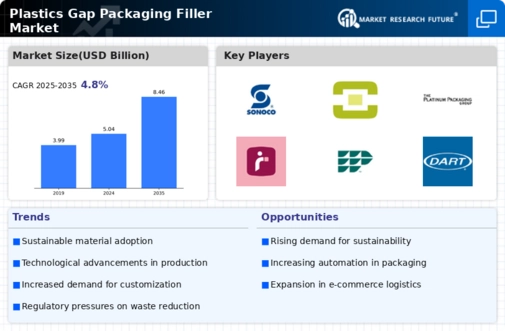Market Growth Projections
The Global Plastics Gap Packaging Filler Market Industry is poised for substantial growth in the coming years. Projections indicate that the market will reach 5.04 USD Billion in 2024, with a robust CAGR of 4.82% anticipated from 2025 to 2035. By 2035, the market is expected to expand to 8.46 USD Billion, reflecting the increasing demand for effective packaging solutions across various sectors. This growth trajectory underscores the industry's adaptability to changing consumer preferences and market dynamics, positioning it as a key player in the global packaging landscape.
Growth in E-commerce and Online Retail
The Global Plastics Gap Packaging Filler Market Industry is significantly influenced by the rapid growth of e-commerce and online retail. As more consumers turn to online shopping, the demand for effective packaging solutions that protect products during transit has surged. This trend necessitates the use of gap fillers to ensure items remain secure and undamaged. According to industry reports, the e-commerce sector is expected to continue expanding, driving the need for innovative packaging solutions. Consequently, the market is anticipated to grow at a CAGR of 4.82% from 2025 to 2035, reaching 8.46 USD Billion by 2035.
Regulatory Support for Packaging Innovations
The Global Plastics Gap Packaging Filler Market Industry benefits from regulatory support aimed at promoting packaging innovations. Governments worldwide are implementing policies that encourage the use of advanced materials and sustainable practices in packaging. This regulatory environment fosters research and development, leading to the creation of more efficient and environmentally friendly fillers. For instance, initiatives that incentivize the use of recycled materials in packaging are gaining traction. Such support not only enhances the industry's growth prospects but also aligns with global sustainability goals, positioning the market favorably for future expansion.
Increasing Consumer Awareness of Product Safety
Consumer awareness regarding product safety and integrity is a driving force in the Global Plastics Gap Packaging Filler Market Industry. As customers become more informed about the importance of secure packaging, businesses are compelled to invest in high-quality fillers that ensure product protection. This trend is particularly evident in sectors such as food and pharmaceuticals, where safety is paramount. Companies are increasingly utilizing advanced fillers to mitigate risks associated with damage during transportation. This heightened focus on safety is likely to contribute to the overall growth of the market, as businesses prioritize consumer trust and product reliability.
Rising Demand for Sustainable Packaging Solutions
The Global Plastics Gap Packaging Filler Market Industry experiences a notable increase in demand for sustainable packaging solutions. As consumers become more environmentally conscious, companies are compelled to adopt eco-friendly materials and practices. This shift is evident in the growing preference for biodegradable fillers and recyclable packaging options. For instance, brands are increasingly utilizing plant-based fillers, which not only reduce environmental impact but also enhance brand image. The market is projected to reach 5.04 USD Billion in 2024, reflecting the industry's adaptation to sustainability trends and consumer preferences.
Technological Advancements in Packaging Materials
Technological advancements play a crucial role in shaping the Global Plastics Gap Packaging Filler Market Industry. Innovations in material science have led to the development of advanced fillers that offer superior protection and performance. For example, the introduction of air-filled and foam-based fillers enhances cushioning properties while minimizing material usage. These advancements not only improve packaging efficiency but also contribute to cost savings for manufacturers. As companies seek to optimize their packaging processes, the adoption of these technologies is expected to drive market growth, further solidifying the industry's position in the global market.


























Leave a Comment